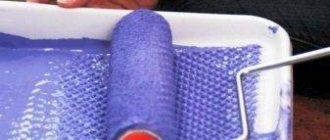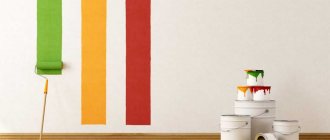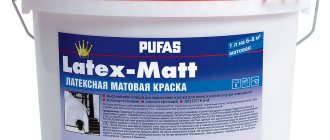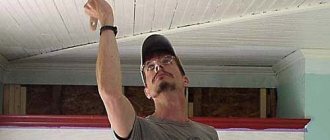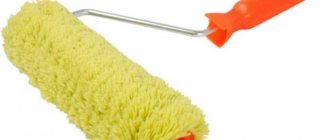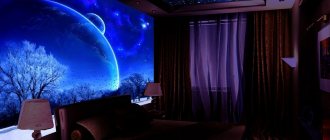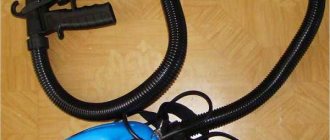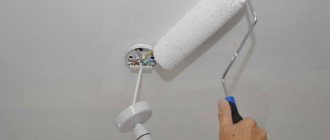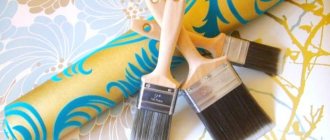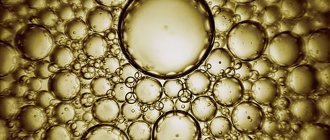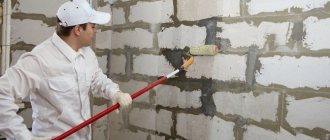Often, a novice builder wonders, water-dispersed paint, what is it? Water-dispersed paint is a chemical product containing a dispersion of solid artificial polymers, which is in water. Often this material is made in the form of a thick liquid consistency and then diluted in the required amount of water. The result is a clear or opaque liquid that is super white and looks like milk.
Using this material you can create an unusual interior. Alpina, aquamarine, acrylate, facade-color, favorite, Aquest-01s are popular brands. In an online store or supermarket you can find: v-1001, vd-ak, vd-ak-1033, vd-ak-104, vd-ak-112, vd-ak-134, vd-ak-13a, vd-ak- 2, vd-ak-200, vd-ak-202, vd-ak-204, vd-ak-205, vd-ak-206, vd-ak-216, vd-va-224, vd-va-27a, vdak-1227, vd-kch-26a, vd-ak-111, vd-va-17, vd-bio (biological additives), vd-ak-266.
Tip: only water can be used as a solvent for such paints or varnishes. Dissolving with other liquids is prohibited.
The composition contains an average of 30 substances. We will now look at some:
- Additional materials: marble chips, colored artificial or natural substances, or talc. Thanks to this material, paints have mechanical properties, for example, a deep matte, glossy, satin or transparent coating.
- Multi-colored tinting pigments that create color (from black to vanilla and white).
- Special substances (stabilizers or thickeners). Film formers serve as binding components, with the help of which a polymer coating is formed on the surface.
Types of paints
Water-dispersed dyes come in different types depending on the additional component: there are styrene-butadiene and polyvinyl acetate bases and acrylic, latex, semi-acrylic, acrylic-latex. Each of these types is different and has its own advantages and disadvantages. Not all materials can be applied with a spray gun.
| Name | Characteristic |
| Polyvinyl acetate base | Has an inexpensive price. Not weatherproof, so it is not used for rooms such as a bathroom, balcony, cellar, kitchen. More often, water-dispersed paint for walls and ceilings is used in rooms where humidity is low. Not used on plastic, whitewash, wallpaper. |
The applied surface becomes plastic. Vapor permeable, allowing the walls to breathe. Used in rooms with high humidity, facades, external walls. They have good adhesion to the surface and coating and are easy to apply. With its help, it is possible to eliminate small cracks up to 0.5 mm. Flammability resistant. Has a matte effect.
Features of acrylic composition
The composition is made using three main components: color pigments, water, acrylic. It has a wide range of colors, so there are no problems with choosing the right shades, it has shine and light fastness. Unlike oil paints, acrylic dries much faster, which makes it a deservedly popular material when used in decoupage, art, painting and for decorative purposes.
The substance is waterproof, quick-drying and practically non-toxic; these properties allow it to be used when working with children. Drying time largely depends on the thickness of the layer of material applied and the coating being painted.
Due to the fact that the composition dries quickly, its use will not create any problems. On the contrary, certain methods are often used to slow down the drying of the solution. This is sometimes required to achieve a better effect.
General recommendations
- First, you need to study in detail the information on the manufacturer's label. Close attention should be paid to the shelf life of the product and its intended purpose.
- As a rule, the packaging indicates the method of use, how long the material takes to dry, on what surfaces it is used and the approximate consumption of the substance. For example, information about the length of time it takes for aerosol in cans to dry can be found in the instructions on the back of the can itself.
- It is not recommended to dissolve dried paints with thinners, as you will not achieve a positive result.
- It is necessary to understand that not all solutions are completely universal. Depending on the surface of the material on which you plan to paint, there are certain differences. For effective work, compositions for special purposes are selected.
- The coating on which the solution is applied also significantly influences the time required to complete drying. Bases with smooth and non-absorbent surfaces, such as glass, iron, and plastic, take the longest to dry. This is characterized by the fact that the drying process is influenced exclusively by the natural evaporation of liquid.
Paper, canvas, wood, foam plastic, cardboard have a porous structure, which helps to significantly reduce drying time.
How to choose acrylic?
- The composition must include a special hardener. It is needed to quickly start a chemical reaction, which is very important for polymerization.
- It is not recommended to use bottles that have expired.
- Pay attention to the volume of the container: if a small amount of solution is needed to complete the job, you should not buy a large jar. It will dry out quickly.
- The composition is non-toxic, practically odorless, so it can be used in a residential area and is harmless to children or pets.
IMPORTANT! Before purchasing a product, it is recommended to find out in detail from a sales consultant what the compositions are. As a rule, they differ in the basic base - water-dispersed or organic. For external work, organic-based solutions are suitable, but for interior painting of walls and ceilings they are used on a water-dispersion basis.
How to make the right choice
In order for the work to be of high quality, you need to choose good material. To make the right choice, you should follow the following group of rules:
- View the general instructions, description, which indicates the manufacturer and country;
- Examine the expiration date;
- Before you go to the store to make a purchase, you should do some statistics and choose a normal manufacturer’s brand (alpine, mattlatex);
- Determine in which room the work will be carried out in order to understand the level of light;
- You need to take into account the surface on which the paint will be applied (concrete, wooden furniture, iron, plasterboard sheets, metal);
- The paint composition must meet the requirement, for example, moisture resistance, fire resistance or vapor impermeability, composition without harmful components;
- It is worth considering how humid the room or space is;
Treatment of painted surfaces to protect against absorption of water-based paint
In order to leave the paint on the surface, the areas to be painted are pre-treated with primers and putties, which close the pores of the material. You don’t have to do this, but then the role of primer will go to the first layer of water-based paint. And if the paint is liquid and the walls are porous, it will be impossible to predict the number of additional layers. This is for those who decided to save a little time on putty and start painting right away.
Preparing walls for painting
The total time you spend will only increase. And if, out of impatience, you apply a new layer of water-based paint before the previous layer has dried (a fairly common mistake, because many people think that everything has already dried out a long time ago, the surface is not wet, the color has appeared, it’s time to paint) then spots will appear on the surfaces or, even worse , the undried layers will stick together and begin to lag behind the surface. They will have to be cleaned off completely, the surface primed and puttied, and painted again.
Advantages and disadvantages
Like all construction paints, water-dispersed acrylic paint has technical characteristics that contain features and disadvantages. Positive qualities include the following properties:
- Doesn't require a lot of time and effort. A beginner and a specialist in his field can handle it with his own hands. Very easy to apply to the surface.
- Drying time is 2 hours. In winter, if there are warm batteries - 1 hour.
- Has mechanical strength. Cleans well.
- The entire color range has richness and texture. During use it does not lose color or shine.
- Covers any texture.
- It has vapor permeability, thanks to which the finished walls and ceiling breathe.
- Long service life. Stays on walls for an average of 15 years.
- The ability to create any shade that is not in the color palette. To do this, you will need to mix pigment and snow-white paint.
- Has adhesion to different surfaces.
- Safe for the environment and people. Contains organic solvents, odorless, no toxic substances.
- Similar in composition to water-based paint.
- Creates the interior design of a room using different colors.
Water-based paint in the living room
Despite its positive qualities, the paint has several disadvantages:
- You need to work with VDC at temperatures above plus 5, humidity should be up to 80%. Otherwise, the film will not form.
- The paint can be stored at room temperature, up to + 30 degrees. Liquid materials may freeze at sub-zero temperatures.
- If work is done at high degrees, the paint will dry quickly, which will lead to the formation of streaks on the surface from the brush.
- Before applying the material, you need to thoroughly clean the surface and treat it with a primer if necessary. Remove old paint.
- The price of the material is above average.
Advantages of VDK
In terms of technical characteristics, dispersed paints are significantly ahead of paintwork materials based on organic solvents. Their main positive properties:
- Safety and harmlessness. Due to the absence of organic solvents in the composition, the dispersion is non-toxic, fireproof, and odorless. When drying, only water vapor is released.
- Easy to apply. Disperse paint is much easier to paint than the usual pentaphthalic enamel or alkyd varnish.
- High adhesion to various surfaces, including those painted with other paintwork materials.
- Fast drying. One to two hours after application, the coating no longer sticks.
- Mechanical strength.
- Fastness of color and texture. The painted surface does not fade or lose its shine.
- Possibility of tinting in any shade.
- Vapor permeability. Water-based dispersion paints create “breathable” coatings.
- Durability. If the technology of surface preparation and application is followed, these paints and varnishes last from 5 to 20 years.
One of the main advantages of water-based dispersion compositions is the possibility of tinting in any shade and high color fastness.
Many people fear that water-based paint or varnish will be easily washed off with water. This is wrong. Dried polymer coatings are very durable and do not dissolve in water.
But resistance to high humidity varies greatly among different VDCs. Only moisture-resistant brands should be used in kitchens and bathrooms.
Preparatory steps before painting
For high-quality work, preparation must be carried out before painting. All rules and instructions must be followed:
- Firstly, you should wash or clean the surface from dust and dirt, greasy stains of old coating or mold. These steps can be performed using a cleaning solution and clean water.
- Calculate how many kg of material per m2 is required. The material consumption depends on this.
- If the walls or ceiling have deep dents or cracks, they must first be repaired with plaster mortar.
How to apply water-based dispersion paint yourself
- The surface must be leveled with plaster and then coated with a primer.
- Places where mold or mildew has formed must be treated with a special antifungal agent.
- If the surface is wet, it needs to be dried.
- The wooden surface should be sanded so that it is as smooth as possible.
Purchase and storage of coverage
On the Internet, on various industrial and construction portals, you can find a lot of proposals for the implementation of acrylic VDK.
Serious companies always guarantee the quality of any paint coating, provide it with reliable storage conditions, and they usually do not have any difficulties with delivery of the goods.
The presence of water in paint components creates some restrictions on storage and transportation methods.
Containers for these purposes must be made of corrosion-resistant materials - stainless or polymer.
VDK cannot be stored at sub-zero temperatures. The permissible freezing limit is no more than 5 times. Transportation is allowed for one month at a temperature of −20 °C, if this can be controlled. This is the only minor drawback for the consumer.
New technologies for the production of acrylic water dispersions make it possible to use their unique properties to coat almost any materials and structures, increasing their resistance to fire and corrosion.
They are not inferior in quality to pentaphthalic paints for painting wooden surfaces, but they dry very quickly and do not have toxic fumes with an unpleasant odor.
This encourages buyers to choose VD-AK and forget about the usual enamels and varnishes collecting dust on the shelves.
Water-dispersion paint is a finishing material that is often used for painting facades and indoor surfaces. It is rightfully considered the most reliable and durable material, and is also environmentally friendly and of high quality. All these properties have contributed to the fact that this material occupies an honorable place in the list of paints. How does water-dispersion paint differ from other paints?
Rules for applying paint
Water-dispersed paint and water-based paint have no differences in application. The execution technology consists of the following stages:
- Before application, mix the paint using a construction mixer or by hand.
- If necessary, we tint the composition. Dry pigment should be diluted in water and then mixed with all the paint.
- The paint is applied using a roller or a nap brush. Pros use paint spray equipment (photo).
- The material should be applied two to three times (layers).
- After use, the roller must not be treated with organic solvents. This can lead to deterioration of the polymer, which can form lumps.
- To wash off excess streaks, use a special remover.
After painting, stripes, “light spots”, etc. often remain on the surface. To prevent such disgrace, it is enough to follow a few rules. This article will discuss the principles of applying water-based paint (see the article “There is a whole world of paints... and varnishes!”).
paints and varnishes
0 votes
+
Vote for!
—
Vote against!
When starting renovation work, most people are faced with the problem of choosing paint that would ideally suit the entire design concept, be durable, of high quality and safe for health. All these requirements are met by water-dispersed paint and varnish material.
Water-dispersed paint is the most common in the construction field; it has gained great popularity due to its unique composition, which combines environmental friendliness, fire resistance and aesthetic appearance.
Content
- Water-dispersion paint - purpose and main components
- Characteristics of water-dispersion paints
- Range of use of water-dispersion paints
- Types of water-dispersion paints
- based on polyvinyl acetate dispersion
- based on styrene butadiene dispersion
- based on acrylic dispersion
- How to choose water-dispersion paint
- Preparing the surface of the room for painting
- Water-dispersion paint application technology
- Safety requirements and storage
Water-dispersion paint - purpose and main components
Water-dispersion paint is a paint and varnish material that is made on the basis of synthetic polymer binders, such as petroleum or resin. The paint is an environmentally friendly and non-flammable product due to the fact that the diluent is not an organic solvent, but water.
The word “dispersive” itself means a mechanical suspension of solid ingredients in liquid, which serves to impart stickiness, viscosity and thickness to the building material.
After applying paint to the surface, the water that was added to the paint material begins to evaporate, after which the water-dispersion coating begins to harden and acquire the properties of high water resistance and effective fire protection.
This paint and varnish material is produced in the form of a liquid paste, and before painting work it is diluted to the required consistency.
Main components of water-dispersion paint:
- Pigments;
- Film formers;
- Fillers;
- Additives for special purposes.
Pigments are substances that give paint the desired shade.
Film formers are binders designed to create a polymer film that adheres firmly to the substrate and is capable of holding all other ingredients. The durability and properties of the coating primarily depend on the quality of the film former.
Fillers are natural or synthetic components. In water-dispersion paints, marble chips, talc and honey are used mainly as fillers, intended to improve the operational and technological characteristics of the paint material.
Special-purpose additives are substances added to the paint composition in order to achieve characteristics such as: accelerating wetting of the substrate, facilitating the process of pigment dispersion, and many others. For example, additives such as coalescents help reduce the film formation temperature.
Characteristics of water-dispersion paints
Water-dispersion paint is an absolutely environmentally friendly, fireproof and easy-to-use material that has no odor.
It is very popular because of its undeniable advantages, namely:
- There are no organic solvents, so the paint is completely environmentally friendly.
- No specific smell.
- Easy to use.
- Fire resistance.
- Vapor permeability, which eliminates the possibility of mold and mildew.
- Adhesion – the ability of paint to stick to a coating for a long time without peeling, blistering or peeling.
- Durability. If all technological requirements are met, the paint can last 10-15 years.
- Quick drying, about 1-2 hours.
- During drying, only water vapor is released.
- High resistance to mechanical damage.
- These paints are relatively cheap.
It is also worth noting the fact that water-soluble paints are not afraid of exposure to high humidity, so they can also be applied to surfaces in the bathroom or kitchen.
A very important property of water-dispersion paint is water resistance. It is better not to use paints with low water resistance in rooms with high humidity. It is very easy to check this property of a paint and varnish material. To do this, you will need to apply paint to a card or some other sample, and then put it in water for 24 hours. If the water-dispersion paint is sufficiently moisture-resistant, then after the allotted time no bubbles, swelling, etc. will appear on it. The verification process can be speeded up by placing the card under running water for about 15 minutes. If the paint is washed off, then it contains no or very little binder, or the paint is not moisture resistant.
The main disadvantage of water-dispersion paint is that it can lose its properties when exposed to low temperatures, so it should only be stored in rooms with room temperature.
Range of use of water-dispersion paints
The scope of application of water-dispersion paints is very wide and depends on what type of paint is used.
They are mainly intended for painting both internal and external elements of a building. They can be used to paint almost any surface - brick, concrete, wood and metal, pre-primed. Very often, this type of paint and varnish material is used to cover tree trunks, while providing them with reliable protection from rodents, cold and heat.
Types of water-dispersion paints
Water-dispersion paint, the price of which depends on many factors, depending on the binding component, is divided into three main types, differing in properties and scope. Namely:
- based on polyvinyl acetate dispersion
- based on styrene butadiene dispersion
- based on acrylic dispersion
Each of these binders has both pros and cons. The choice depends on which properties of the paint and varnish material are important in specific cases.
Water-dispersion paints based on polyvinyl acetate dispersion (PVA)
This type of paint is the cheapest. They have low resistance to moisture, so their scope of application is rather narrow. Water-dispersed polyvinyl acetate paint is used mainly for painting walls and ceilings of dry rooms.
Water-dispersion paints based on styrene-butadiene dispersion
The advantage of this type of paint is that they are highly water-resistant, but styrene-butadiene dispersions have limited light resistance. This limits their scope of use. They are used to paint interior surfaces, but it is highly not recommended to use these paints for exterior work, since they will begin to turn yellow over time when exposed to light.
Water-dispersion paints based on acrylic dispersions
They are more expensive, unlike previous types of paints, but more versatile and often used.
Acrylic dispersions or, as they are often called, acrylate dispersions, are able to preserve the color of paint under any influence, even with intense ultraviolet irradiation. Water-dispersion acrylic paint dries quickly enough, is resistant to washing, has durability, water resistance, vapor permeability and makes the surface elastic. Water-dispersed acrylate paints apply perfectly, have very good adhesion, and form a perfectly even coating. It is capable of painting over small cracks up to 0.5 millimeters in size on the surface.
How to choose water-dispersion paint
The choice of water-dispersion paint and varnish material depends on a large number of factors:
- Manufacturer country
- Trademark (it is better if the company has already established itself in the world market, since young brands are not a guarantee of reliability, quality and durability)
- Room illumination level
- Necessary decorative property
- Room humidity level
- Temperature
- Type of surface to be treated (wood, concrete, iron, etc.)
- Availability of specific requirements (moisture resistance, vapor permeability, etc.)
Also, when choosing water-dispersion paint, you should pay attention to the quality certificate of the selected product. After this, check with the seller for compliance with the paint storage conditions, since improper conservation of the paint and varnish material can lead to a violation of the thickness of the paint, as a result of which its performance characteristics deteriorate and in the future it may delaminate.
Preparing the surface of the room for painting
Before applying paint, the coating should be thoroughly cleaned of dust, dirt, and grease, as they can negatively affect the fresh coat of paint. Defects and loose areas should be leveled with a cement composition. If there is mold on the surface being treated, it must be removed mechanically. Experts advise that after cleaning, apply a layer of fungicide and leave the room for 12 hours; it helps remove all unwanted microorganisms.
So, before applying paint, the surface must be completely dry and clean.
Water-dispersion paint application technology
Like all paints, waterborne paints should be moved carefully before use. Depending on the condition of the surface, it may be necessary to apply one to three layers of water-dispersed paint. If a wall or ceiling is being painted for the first time, they need to be treated with a primer. The priming process is carried out using a roller or brush with further drying, which may take from 1 to 2 hours.
The consumption of water-dispersion paint is approximately 140-180 g/m2.
To obtain the required shade of paint, special dyes are added to its composition.
The first layer of paint is applied from the side of the window, parallel to it.
To obtain the required shade of the coloring agent, a coloring pigment is added to the white base, which is moistened in water and mixed before mixing.
To cover walls or ceilings with paint, you can use a roller, brush or spray. With a roller, in most cases it is necessary to apply about two layers of paint with an interval of four hours between layers, it all depends on the specific case. The first layer can be applied with a brush, only in this case you should use a paint composition diluted with water (0.5 liters of water per 5 kg of paint), and it is better to paint the second layer with a roller to achieve a smoother surface. Using a sprayer, paint a wall or ceiling at a distance of about one meter.
Safety requirements and storage
For your own safety, before using the paint, you should apply protective cream to your face and hands and wear glasses.
The premises to be painted must be equipped with supply and exhaust ventilation to ensure the safety of the work area.
Water-dispersion paints GOST 9880.5 should be stored at a temperature of 0-30 °C. Storage is allowed at temperatures up to 40°C below zero, but for no more than one month.
How are walls painted?
The walls are painted according to the same principle as the ceiling. But there are still differences. After all, this is a horizontal surface, and here is a vertical surface.
1. Use a brush to go through all hard-to-reach areas: in corners, under ceilings and at lower baseboards, near doorways. To avoid staining the latter with paint, apply masking tape to them. Remove it only after the paint has dried. That is, in 10-15 days.
3. Paint the wall not randomly, but in parallel stripes (vertical or horizontal) about 70 cm wide. They should overlap by about 10 cm.
4. Apply second, third, fourth (why not?) layers of paint. And so that the direction of the subsequent one differs from the previous one.
Are you afraid that the paint will lie unevenly? Light the wall with a carrying lamp. After all, all errors that are invisible in daylight are detected in artificial light.
For information on how to work with oil paints, read the article: “Painting surfaces with oil paints and enamels.”
How to properly plaster walls and ceilings, see the instructions at the link: https://remontspravka.com/stucco-wall-ceil/
How to install beacons and use them in plastering work? - you will also find it on our website.
Types of water-dispersion paints
Currently, 5 formulation options are used based on various binding components:
- With the addition of polyvinyl acetate (PVA glue, the material is classified as VD-VA). Paints based on it are not waterproof. The coating turns yellow over time. The PVA composition promotes the formation of an airtight, opaque film on the treated surface. Therefore, it has a rather narrow scope of application, despite the low price. There are weather-resistant and even water-resistant PVA copolymers, but they are much more expensive. The material is suitable for interior painting of dry warehouses, basements and heated utility rooms.
- Butadiene-styrene dispersions (BS) (VD-SC). They are good as waterproof materials, but have low light resistance and also form airtight films. Materials based on these dispersions are relatively cheap. They are used for interior painting of walls and ceilings in bathrooms, kitchens and corridors. Surfaces are easy to clean with water.
- Styrene - acrylate dispersions (SA) (VD-AK). They are more expensive than the previous ones and are more weather resistant. They have good porosity and vapor permeability. They have high adhesion to many types of materials due to their small particle sizes (0.08-0.16 microns). They have a deep degree of penetration into the porous base and thereby contribute to its strengthening.
- Versatate dispersions (VS) (VD-AK). They are a relatively new type of coating and have the properties of acrylic dispersions. But they cost a little less.
- Acrylic dispersions (A) (VD-AK). More versatile and expensive compared to styrene-acrylate ones. They have the highest resistance to mechanical stress and ultraviolet resistance. They are used to produce wood coatings and other high-quality paints for various applications. On building facades, they can serve under unfavorable conditions for up to 10 years and up to 30 years in a temperate climate zone, if the rules of painting technology are followed.
What should you ask from a master?
As a rule, an employer expects almost a miracle from a professional painter. Like, that’s why he’s a professional. And he examines the painted surface almost under a magnifying glass. However, the regulatory requirements (which customers must follow) for craftsmen are not so strict.
Sometimes the problem is not with the artist, but with the paint.
For example, SNiP 3.04.01-87 states that defects should be looked for at a distance of 3! meters. And if from this distance you cannot see: “stripes, stains, smudges, splashes, abrasion... translucency, peeling, wrinkles, visible grains, film clots, marks from brushes, rollers or tampons” - there is nothing to blame the master for.
Another important note in SNiP: “In places where surfaces painted in different colors meet (where paint of one color borders on another (author’s note), the curvature of the lines... should not exceed 5 mm for simple painting, 2 mm for improved painting, high-quality - 1 mm." In short, if the master is not cheap, he can be forgiven for a deviation of only 1 mm.
Acrylic paint has high technological and performance characteristics. Familiarity with the composition and properties will help in choosing the appropriate material for painting walls in a particular situation. Studying application technology will be useful in the case of decorating and furnishing premises with your own hands.
Professional secrets for interior work
Interior painting of residential premises has its own nuances. When working with VDK, air humidity increases significantly. To create a safe and comfortable environment, it is advisable to install forced ventilation. At the same time, the paint and varnish material will dry faster and better.
To make the coating look perfect, use the following recommendations:
- You need to start applying paint parallel to the frame structure, from the side of the window.
- The first time it is better to paint with a brush, a composition diluted in a ratio of 0.5 liters of water to 5 liters of paint. Subsequent layers are applied with a roller to achieve a leveled surface.
- Each coat of paint is applied at intervals of 3 hours.
- The sprayer will significantly speed up painting the walls. It can be used at a distance of a meter from the windows.
- If the surface is highly absorbent, it may be necessary to apply three layers to obtain a high-quality coating.
- Before painting the interior walls, it is better to dismantle the baseboards or cover them with masking tape.
- If, according to the design plan, you need to paint one wall in two different colors, which will visually divide the room into zones, for example, for working at the computer and relaxing in front of the TV, use the same masking tape.
- Always consider the natural light factor. The final coat of paint on the ceiling will look better if applied perpendicular to the wall with the light source.
Water-dispersed paint and textured rollers with stencils will help create stylish and bright interior elements.
Features, composition and characteristics of acrylic paint
When consumers are faced with the question of which paint to buy, most choose acrylic paints and varnishes. The products are based on polymers: ethyl, methyl and acrylic butyl. The binding element is an aqueous suspension of synthetic resins.
Pros of acrylic paints:
- versatility - applicable to any surface;
- non-toxic;
- low gas permeability;
- moisture resistance;
- resistance to aggressive environments (chemicals).
Acrylic paints and varnishes are used for painting all kinds of surfaces: ceilings, walls, facades.
Types of interior paint products
Acrylic paints come in several types. Some are intended for finishing and construction work, others are for painting metals, and others are used by artists and painters.
Acrylic glossy paint for walls
Creates a beautiful appearance and a more durable coating compared to matte counterparts. Recommended for use in rooms with high humidity. Visually expands the space of the rooms, but at the same time makes visible imperfections and unevenness of the walls.
Matte water-dispersion
Does not fade over time, maintaining its original appearance. It is effective in painting uneven walls, as it hides minor imperfections.
Glossy
It looks expensive and impressive. Popular for painting walls and finishing ceilings. Look great in modern and progressive interiors. Metal and glass furniture pieces fit seamlessly into rooms with a glossy finish.
Water-based acrylic
Produced on a water basis. Differs from analogues in increased water resistance. The coatings look rich and beautiful due to the addition of pigments.
Pearlescent interior acrylic wall paint
Gives the wall a unique look. The material contains a pigment that helps refract sunlight.
Therefore, in different lighting conditions and at different times of day, the walls look special.
Pearl effect paint is easy to apply to any surface and can be used in tandem with wood trim, liquid wallpaper and painted drywall.
Advantages of acrylic polymer dispersions
The choice of this modern material is a priority for creating coatings that have not only decorative, but also excellent functional qualities. The good reputation of this product is based on its following qualities:
- has excellent adhesion and is used for finishing brick, concrete, plastered and wooden surfaces;
- It is waterproof, allowing you to wash any painted surface;
- lasts a very long time - if the application technology is followed, the coating can last on average 15 years;
- does not fade with prolonged exposure to intense ultraviolet irradiation;
- does not contain toxic substances;
- does not smell of anything and does not cause allergic reactions;
- has high elasticity and resistance to mechanical stress;
- Well masks minor defects of any surface;
- creates a film with a “breathing” effect, which makes it possible to prevent mold from spreading in damp rooms;
- the composition does not contain flammable components;
- The painting process requires minimal preparation and is usually straightforward.
The scope of application of this paint is not limited to construction and repair. In light industry it is used for dyeing textile materials. Artists design objects of decorative and applied art and create paintings with its help.
Do-it-yourself painting of walls with acrylic paint: progress of work
In order for the coating to please you with its appearance for a long time, it is necessary to prepare the walls for painting. To do this you need:
- remove old paint, wallpaper, plaster and whitewash from the surface, inspect the walls for cracks - there should be none;
- degrease the walls with a solution of construction primer or White Spirit;
- level the surface with 1-2 layers of plaster, then apply a layer of putty and sand;
- apply a special primer under acrylic paint, this will fix the putty layer and prevent it from falling off;
- If the work is carried out in a room with high humidity, apply a primer that prevents the formation of fungus to prevent the appearance of mold.
How to paint
Now the surface is ready for painting. Draw a sketch with a pencil, if provided, and then start applying paint. The following recommendations will help you perform high-quality staining:
- prepare a roller, brush, and paint container for work;
- start painting walls from hard-to-reach areas - corners and perimeter, then start painting the middle;
- the first layer can be applied in any direction, and the last one - towards the window;
- hard-to-reach places are painted with a brush in one layer, the rest of the surface is coated twice.
How to dilute
Acrylic paint is usually diluted with water, which must meet the following requirements:
- be within 20⁰С, in the case of façade paint – 5 degrees above the street temperature (minimum 16-18⁰С);
- have no impurities - it is better to use distilled water or boil tap water and let it sit.
Water is the optimal solvent, but in addition to it, special liquids are provided - thinners (universal, specialized and artistic).
How much consumption per m2
In accordance with the established rule, the consumption rate of acrylic paint is 180-200 g. per 1 m2. This condition applies when working with a smooth surface (finishing putty or abrasive cloth). If the working surface is rough and uneven, the flow rate will be increased.
Acrylic paint drying time
When drying, the acrylic composition goes through certain stages, regardless of the application method. If liquid acrylic was used when painting, then it will take much longer for complete drying, since this is required by the thinners that are used.
Stage 1 – “Evaporation”
This is liquid acrylic itself, which evaporates during application to the surface. Once in the atmosphere, solvents and water leave the paint; this is the first stage of drying. For liquid formulations, this stage may take several days.
Stage 2 – “Film Formation”
After the light volatile substances evaporate, the paint begins to form a film. In those places where the acrylic is laid down thinly, the film will appear faster, and where the film is laid down in a thicker layer, its formation will take up to 8 hours.
Stage 3 – “Drying without sticking”
At the next stage of drying, you can check the dryness of the surface by applying your fingers; if the paint has dried completely, then touching it will not spoil the painting. Usually this stage occurs after 24 hours.
Stage 4 – “Deceptive State”
At this stage, it seems that the paint is completely ready for the application of the next layers, epoxy resin or varnish, but this is not entirely true. Although the paint looks dry on the outside, the inner layers are not yet fully formed and applying different compounds to them can lead to paint peeling or smearing. Typically it takes 48 hours to complete this stage.
Stage 5 – “Complete drying”
At the last stage of drying, the acrylic completely hardens. As a rule, all volatile substances and evaporators are completely evaporated at this stage and the coating is ready for the next application of varnish, additional layers of solution or epoxy. Acrylic paint may release small amounts of volatiles for several weeks. The last stage takes 72 hours.
Advantages
Acrylic paints and varnishes have many advantages over their analogues. Among the main advantages:
- long service life;
- practicality and economy;
- quick drying (1/2-2 hours depending on the composition), can be used for painting facades in rainy weather;
- absence of unevenness as a result of the work;
- excellent water-repellent characteristics;
- maintaining brightness and color saturation;
- allows air to pass through, allowing use on wooden surfaces;
- low price tag and the ability to apply it yourself.
Today, consumers choose modern, inexpensive, environmentally friendly and high-quality materials. These advantages are inherent in acrylic paint. It consists of polyacrylics, pigments and fillers - components that guarantee excellent performance characteristics of the product.
Painting process
Color is added to the thoroughly mixed paint to obtain the planned color. The volume of product required for the job is calculated, then all the paint is tinted at once. It happens that several cans of the same paint from the same manufacturer differ in color.
It is important that the brightness of the color changes after the surface dries. To obtain a rich tone, apply up to 3 layers of coloring material. The following methods are used to apply paint to the wall:
- Brush. It is used for high-quality painting of corners, perimeter and places that are difficult to access.
- Roller. Helps distribute paint evenly over a large area.
- Spray. Typically used for painting large spaces. Working with a spray gun requires practical experience, then the painted surface will be smooth and streak-free.
Painting the room starts from the window. Typically, the first layer is applied in a horizontal plane, and all subsequent layers are applied vertically. This method of applying paint allows the wall to look more natural.
Carefully reading the instructions will help you properly dilute the paint with water for each of the applied layers. First of all, hard-to-reach places, corners and the perimeter of one wall are coated. Only then paint the entire surface with a roller. Having finished working with the wall completely, move on to the next wall.
The next layer is applied after making sure that the previous layers have already dried. Water-based paint is a safe, environmentally friendly paint and varnish product, ideal for decorative finishing of premises. The results of its use give joy and good mood for many years.
Useful video
| Styrene butadiene base | The main positive quality is water resistance. The disadvantages include light fastness, since after some time of use the paint will take on a yellow tint. Due to this, the scope of application is small. It is not recommended for use in residential premises or apartments; it is often used for façade and exterior painting. Considered harmful to health. Has good density. Possesses fire hazard properties. |
| Acrylic base | Water-dispersed acrylic paint is an expensive material, but it is universal and often used. The second name for acrylic bases is acrylate. They are not afraid of light, retain their performance qualities for years, and are also not afraid of ultraviolet rays. Positive qualities include ease of washing, dries quickly after application, durable and strong. |
